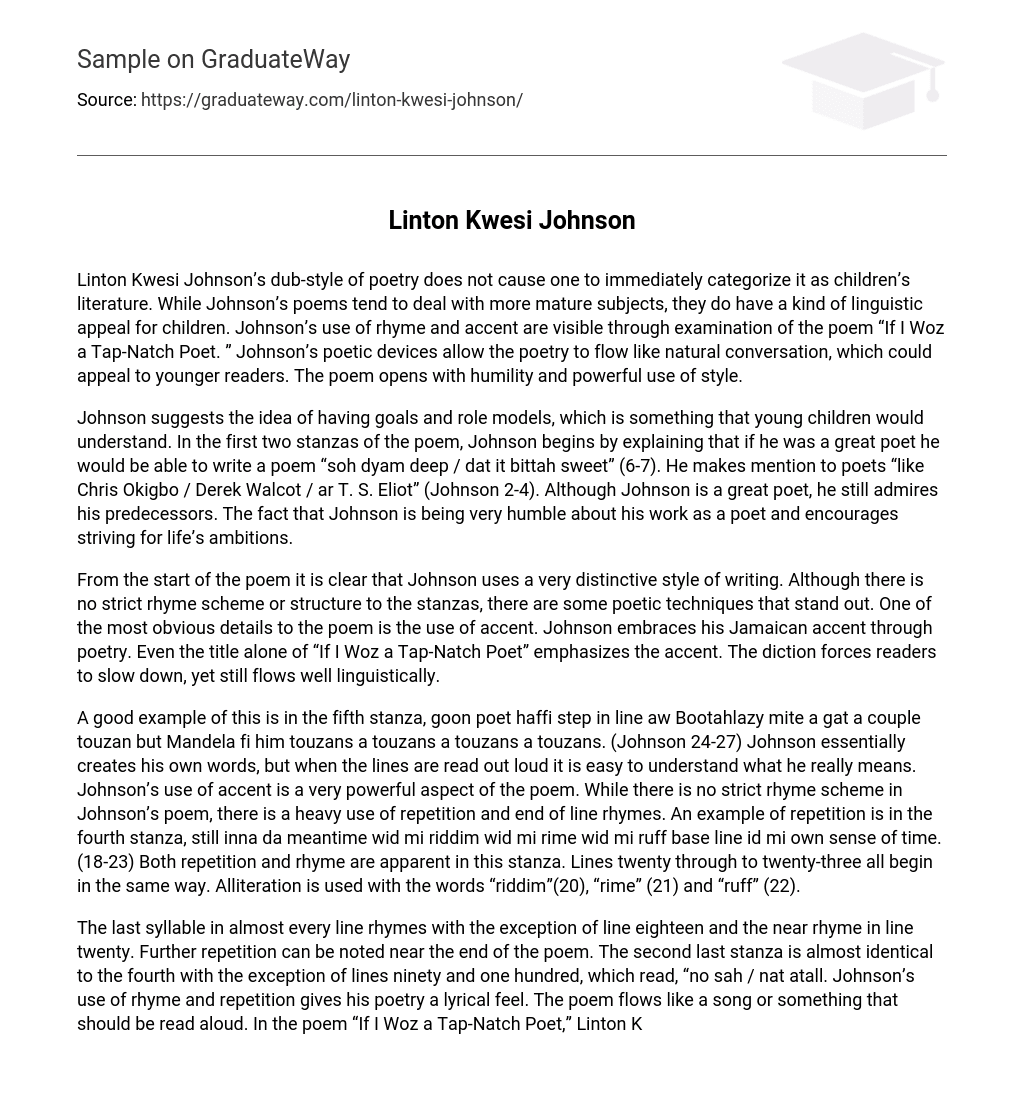Linton Kwesi Johnson’s dub-style of poetry does not cause one to immediately categorize it as children’s literature. While Johnson’s poems tend to deal with more mature subjects, they do have a kind of linguistic appeal for children. Johnson’s use of rhyme and accent are visible through examination of the poem “If I Woz a Tap-Natch Poet. ” Johnson’s poetic devices allow the poetry to flow like natural conversation, which could appeal to younger readers. The poem opens with humility and powerful use of style.
Johnson suggests the idea of having goals and role models, which is something that young children would understand. In the first two stanzas of the poem, Johnson begins by explaining that if he was a great poet he would be able to write a poem “soh dyam deep / dat it bittah sweet” (6-7). He makes mention to poets “like Chris Okigbo / Derek Walcot / ar T. S. Eliot” (Johnson 2-4). Although Johnson is a great poet, he still admires his predecessors. The fact that Johnson is being very humble about his work as a poet and encourages striving for life’s ambitions.
From the start of the poem it is clear that Johnson uses a very distinctive style of writing. Although there is no strict rhyme scheme or structure to the stanzas, there are some poetic techniques that stand out. One of the most obvious details to the poem is the use of accent. Johnson embraces his Jamaican accent through poetry. Even the title alone of “If I Woz a Tap-Natch Poet” emphasizes the accent. The diction forces readers to slow down, yet still flows well linguistically.
A good example of this is in the fifth stanza, goon poet haffi step in line aw Bootahlazy mite a gat a couple touzan but Mandela fi him touzans a touzans a touzans a touzans. (Johnson 24-27) Johnson essentially creates his own words, but when the lines are read out loud it is easy to understand what he really means. Johnson’s use of accent is a very powerful aspect of the poem. While there is no strict rhyme scheme in Johnson’s poem, there is a heavy use of repetition and end of line rhymes.
An example of repetition is in the fourth stanza, still inna da meantime wid mi riddim wid mi rime wid mi ruff base line id mi own sense of time. (18-23) Both repetition and rhyme are apparent in this stanza. Lines twenty through to twenty-three all begin in the same way. Alliteration is used with the words “riddim”(20), “rime” (21) and “ruff” (22).
The last syllable in almost every line rhymes with the exception of line eighteen and the near rhyme in line twenty. Further repetition can be noted near the end of the poem. The second last stanza is almost identical to the fourth with the exception of lines ninety and one hundred, which read, “no sah / nat atall. Johnson’s use of rhyme and repetition gives his poetry a lyrical feel. The poem flows like a song or something that should be read aloud.
In the poem “If I Woz a Tap-Natch Poet,” Linton Kwesi Johnson utilizes multiple poetic techniques. Placing emphasis on accent throughout the poem allows for it to flow nicely as spoken word. The use of rhyme and repetition create a lyrical feel. Johnson also exhibits a level of humility and modesty through his appreciation for other great poets. Irony can be found in a poem written by an accomplished writer about striving to be a great poet.





